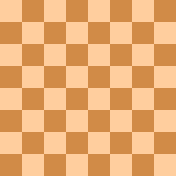
Back تبييت Arabic Qalaqurma Azerbaijani Ракіроўка Byelorussian Ракіроўка BE-X-OLD Рокада Bulgarian Rokada BS Enroc Catalan Rošáda Czech Роккир CV Castellu (gwyddbwyll) Welsh
Initial positions of kings and rooks. Kings may castle to the indicated squares.
|
White has castled kingside; Black has castled queenside.
| ||||||||||||||||||||||||||||||||||||||||||||||||||||||||||||||||||||||||||||||||||||||||
Castling is a move in chess. It consists of moving the king two squares toward a rook on the same rank and then moving the rook to the square that the king passed over.[2] Castling is permitted only if neither the king nor the rook has previously moved; the squares between the king and the rook are vacant; and the king does not leave, cross over, or finish on a square attacked by an enemy piece. Castling is the only move in chess in which two pieces are moved at once.[3]
Castling with the king's rook is called kingside castling, and castling with the queen's rook is called queenside castling. In both algebraic and descriptive notations, castling kingside is written as 0-0 and castling queenside as 0-0-0.
Castling originates from the king's leap, a two-square king move added to European chess between the 14th and 15th centuries, and took on its present form in the 17th century. Local variations in castling rules were common, however, persisting in Italy until the late 19th century. Castling does not exist in Asian games of the chess family, such as shogi, xiangqi, and janggi, but it commonly appears in variants of Western chess.
- ^ "FIDE Laws of Chess taking effect from 1 January 2018". FIDE. Retrieved 12 July 2020.
- ^ Article 3.8.2 in FIDE Laws of Chess[1]
- ^ Pandolfini, Bruce (1992), Pandolfini's Chess Complete: The Most Comprehensive Guide to the Game, from History to Strategy, Simon & Schuster, ISBN 9780671701864, retrieved 13 January 2014
